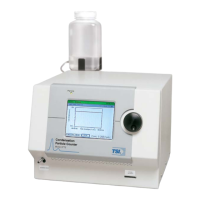Instrument Description 3-11
Basic Instrument Functions
This section describes basic instrument functions.
Concentration Measurement
Particle concentration is presented as particles per cubic centimeter
(p/cc) and displayed on the front panel LCD both in numeric form
and in graphic form. Particle concentration is determined from the
count rate (particles counted per tenth of a second) and the aerosol
flow rate entered into the firmware by manufacturer. This flow rate
is very close to its nominal value of 0.3 L/min (300 cubic
centimeters per minute (cm
3
/min)). Particle concentration is live-
time corrected for coincidence. Refer to Chapter 6 “
Live-time
Counting” for more information.
Totalizer Mode
Totalizer mode counts number of particles in a given time period.
This mode is used to improve counting resolution at very low
particle concentrations. Time, number of counts, and concentration
are shown on the front panel display.
High and Low Flow Modes
The Model 3775 CPC has user-selectable high and low inlet sample
flow modes. The high inlet sample flow mode, 1.5 L/min, is
preferred for smaller particles because particles are transported
more quickly through sampling lines, reducing particle diffusion
losses. The low flow mode, 0.3 L/min, is primarily used with the
Scanning Mobility Particle Sizer
TM
Spectrometer (TSI Model 3936
SMPS
TM
) to measure size distributions for wider particle size range.
Water Removal
When the aerosol sample has a dew point above the condenser
temperature of 14°C, water vapor may condense on the walls of the
condenser and run back into the saturator, contaminating the
butanol over time. Unlike its predecessor, the Model 3022A, the
Model 3775 CPC is able to capture condensed water vapor and
remove it, significantly reducing butanol contamination. The water
removal process increases the butanol consumption. For additional
information refer to
Chapter 4.

